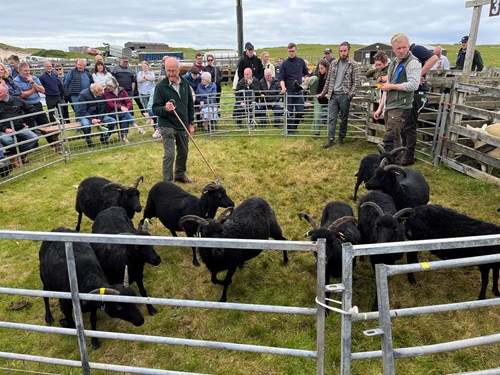Supporting Scotland’s crofting communities

Crofters participate in the Uist Agricultural Show
Crofting provides more than food production; it provides high-nature value farming, appealing landscapes, a mosaic of habitats for flora and fauna, local businesses, economic and community benefits and population retention in remote areas.
Our aim in supporting this vital aspect of agriculture in Scotland is to strengthen and progress modern crofting and give crofters the advice and knowledge that will ensure that they can thrive. Many of our advisors are crofters themselves and understand crofting systems and challenges through their own experiences.
In all the crofting counties, SAC Consulting has a team of local, independent advisors who are well versed in the many aspects of crofting – and there are, indeed, many. Services such as business planning, agricultural support payment scheme applications, crofting registration, sheep records, Agri-Environment and Climate Scheme (AECS) and Crofting and Agricultural Grant Scheme (CAGS) applications are very popular throughout the communities we operate in throughout Scotland.
We also work closely with the Crofting Commission and the Scottish Government’s Rural Payments and Inspections Division (SGRPID) so that we know what lies ahead.
Crofting Commission applications
Of course, we can also provide expertise and support with completion of applications for the Crofting Commission, such as:
- Sub-let: Temporary transfer of a crofting tenancy
- Assignation: Permanent transfer of a crofting tenancy
- Decrofting: Removing land from croft tenure, usually for the purposes of house building
- Apportionment: Apportioning shares in your common grazing that are fenced for your own sole use
- The crofting register: A definitive map-based record of the extent of your croft – which is required to complete many of the above regulatory actions
Crofting legislation can be complex, and we hear many questions and queries from crofters on this topic.
Common grazings
Running a common grazing is no simple task. However, it offers many benefits to crofters, including communal facilities, stock clubs, bull hire and a better grant rate.
Our advisors are well placed to help common grazing committees look at setting up in office, co-operative structures, agri-environment, and many practical livestock and cropping issues. This is something that we see bringing in income and helping grazings to add facilities such as fanks, weighing systems, upmarket crushes and even sheds.
Grants to improve your croft
The Crofting Agricultural Grant Scheme (CAGS) provides grants for crofters, whether tenant or owner occupier crofter, to make improvements to their crofts and help to sustain their business.
Funds of up to £25,000 for individual crofters can be used for capital projects, such as the construction of agricultural buildings, fencing, drainage, woodland, grassland improvement, access tracks, handling facilities and hardstandings. The grant rate for an individual crofter is 60 per cent, and for crofters under the age of 41 and in business for less than five years, it is 80 per cent.
Common grazing committees are eligible for 80 per cent grant rate, up to £125,000. The rate rises to 90 per cent where the committee are under 41 – a rare event! Applications are accepted by SGRPID at any time of year and are judged on several criteria, including value for money and contribution to the economy.
We often find that the application and claim process benefits from our support to ensure a thorough and successful submission.
Croft House Grant (CHG)
The CHG is designed to help retain people within the crofting areas of Scotland by providing grants for crofters to improve and maintain the standards of crofter housing.
Funding of 40 per cent of the costs up to a maximum of £38,000 in high priority areas and up to £28,000 in standard priority areas is available. Funding can be used for major repairs, internal improvements, and rebuilding work as well as new builds.
With many years of experience in this kind of application, our team regularly provides advice to support with the development of the five-year plan as well as guidance to help crofters to navigate the application process.
Technical Advice
livestock underpins the Scottish agricultural beef and sheep systems, with some high-quality beef calves, lambs and draft ewes springing from the crofting areas. Rationing is important, along with testing silage, especially with bought in feed costs increasing. Getting soil fertility right means better crops of grass - which is our cheapest feed – and soil analysis costs very little. As well as having practical experience, we can call on our colleagues in research to make sure we have the latest information, which improves stock and crop performance.
Subsidies and financial support
Necessary to support all agricultural businesses at the moment and an area that we understand well. Changes are underway and crofting will deliver many of the Government’s aims, for example, in managing carbon. The rules around subsidies and support are often complex but we are always up to date, looking ahead, and can help ensure that your crofting business is supported and rewarded.
Crofts come in various shapes and crofters are all unique – we are here to offer bespoke advice for you to meet your aspirations for your crofting business.
Siobhan Macdonald
Senior Consultant and Area Manager
Posted by Siobhan Macdonald on 09/12/2022
